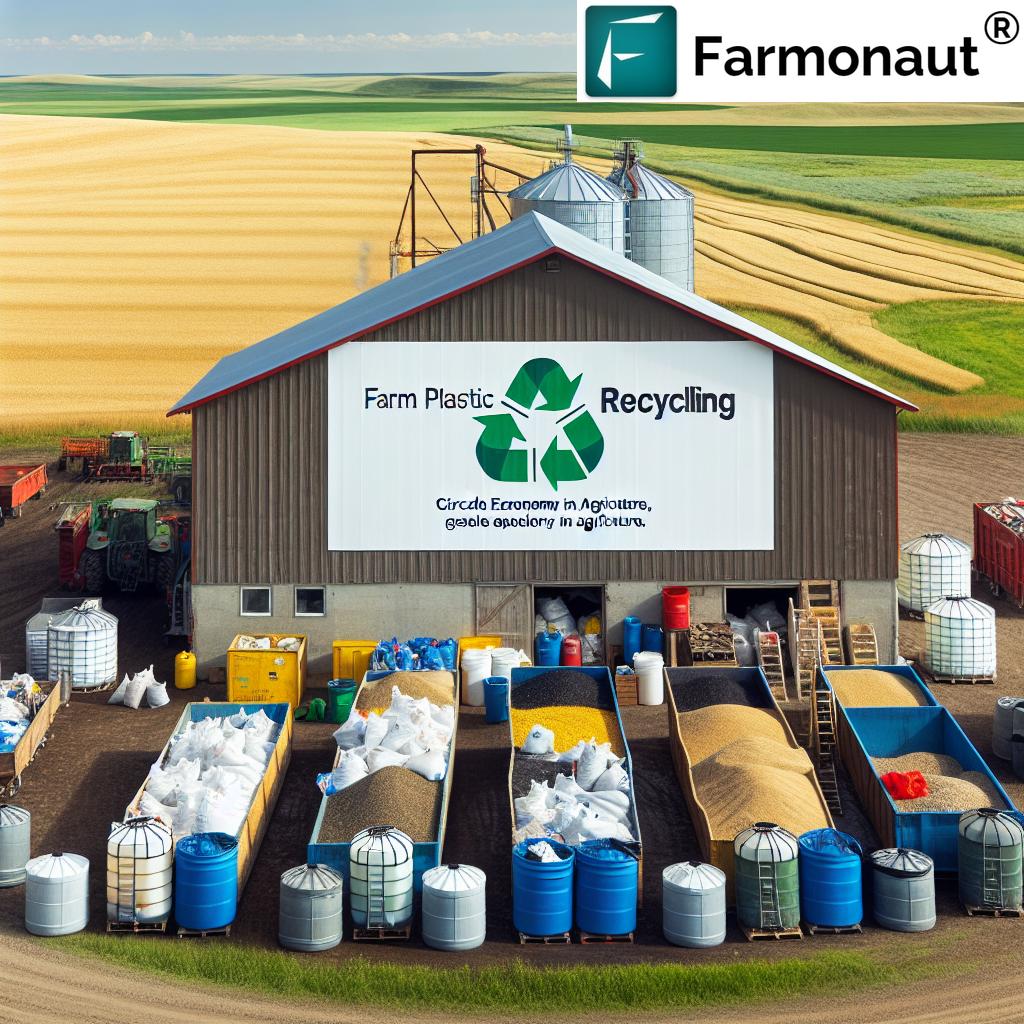Canadian Fertilizer Industry: New Leadership to Drive Innovation and Economic Growth in Agriculture Sector
“Canada’s fertilizer industry contributes over $42 billion annually to the economy and employs 118,000 workers across the supply chain.”
In a significant development for Canada’s agricultural sector, we are witnessing a new era of leadership in the fertilizer industry. This change at the helm of a major association signals a renewed focus on creating a policy and regulatory environment that fosters global competitiveness in the fertilizer sector. As we delve into this topic, we’ll explore how this shift is poised to drive innovation and economic growth in one of Canada’s most vital industries.
The Appointment of New Leadership
The Board of Directors of Fertilizer Canada has appointed Michael Bourque as the new President and CEO, effective immediately. This strategic move comes at a crucial time for the industry, as it navigates complex challenges and seeks to advance its strategic priorities.
Lindsay Kaspick, Fertilizer Canada Board Chair, expressed confidence in the appointment, stating, “Michael brings extensive experience in policy development and industry association management, making him ideally suited to lead Canada’s fertilizer sector through today’s complex challenges and to advance the industry’s strategic priorities.”
Michael Bourque’s background is particularly noteworthy. He previously served as CEO of the Canadian Real Estate Association and as President and CEO of the Railway Association of Canada. His experience extends to senior public policy roles on Parliament Hill, leadership in the federal public service, and government relations in the chemical industry. This diverse background positions him well to address the multifaceted challenges facing the fertilizer sector.
The Economic Significance of Canada’s Fertilizer Industry
To truly appreciate the importance of this leadership change, it’s crucial to understand the economic significance of the Canadian fertilizer industry. Let’s take a closer look at some key economic indicators:
| Economic Indicator | Estimated Value | Impact |
|---|---|---|
| Annual Economic Contribution | Over $42 billion | Significant boost to Canada’s GDP, supporting various sectors |
| Employment (Direct and Indirect) | 118,000 workers | Major source of employment across the supply chain |
| Export Value | Estimated in billions | Enhances Canada’s position in global trade |
| Agricultural Productivity Increase | Substantial | Crucial for food security and agricultural output |
| Research and Development Investment | Millions annually | Drives innovation in sustainable agriculture practices |
These figures underscore the critical role the fertilizer industry plays in Canada’s economy. It’s not just about the direct financial contribution; the industry’s impact ripples through various sectors, from agriculture to transportation and beyond.
Strategic Priorities Under New Leadership
With Michael Bourque at the helm, the focus is clear: to advocate for policies that encourage investment, growth, and productivity in Canada. This approach aims to position Canada as a reliable trading partner and supplier of value-added fertilizer products worldwide.
Key priorities include:
- Policy Advocacy: Pushing for a regulatory environment that supports industry growth and innovation.
- Global Competitiveness: Enhancing Canada’s position in the global fertilizer market.
- Innovation: Encouraging research and development in sustainable fertilizer practices.
- Economic Growth: Fostering conditions that contribute to overall economic prosperity.
- Sustainability: Balancing productivity with environmental stewardship.
These priorities align well with the needs of the agricultural sector and the broader Canadian economy. By focusing on these areas, the industry is positioning itself to play a crucial role in Canada’s economic future.
The Role of Fertilizer in Canadian Agriculture
“The Canadian fertilizer sector produces and distributes four main types of fertilizers: nitrogen, phosphate, potash, and sulphur.”
Understanding the types of fertilizers produced in Canada is crucial to appreciating the industry’s complexity and importance. Each of these fertilizers plays a unique role in agricultural productivity:
- Nitrogen: Essential for plant growth and chlorophyll production.
- Phosphate: Crucial for root development and energy transfer in plants.
- Potash: Improves plant strength and disease resistance.
- Sulphur: Important for protein synthesis and chlorophyll formation.
The diversity of fertilizers produced underscores the industry’s vital role in supporting various agricultural needs across different crops and soil types. This diversity also positions Canada as a key player in the global fertilizer market, capable of meeting a wide range of agricultural demands.
Innovation and Sustainability in the Fertilizer Industry
As we look to the future of the Canadian fertilizer industry, innovation and sustainability are at the forefront. The industry is committed to developing and implementing new technologies that enhance productivity while minimizing environmental impact.
One area where technology is making a significant impact is in precision agriculture. Companies like Farmonaut are leading the way in this field, offering satellite-based farm management solutions that help farmers optimize their fertilizer use. Through its crop plantation and forest advisory services, Farmonaut enables farmers to make data-driven decisions about fertilizer application, reducing waste and improving crop yields.
Another crucial aspect of innovation in the fertilizer industry is the development of more environmentally friendly products. This includes slow-release fertilizers that reduce nutrient runoff and organic fertilizers that improve soil health over time. These innovations not only benefit farmers but also contribute to the industry’s sustainability goals.
The Global Context: Canada’s Position in the World Fertilizer Market
Canada’s fertilizer industry doesn’t operate in isolation; it’s a key player in the global market. As one of the world’s largest fertilizer producers and exporters, Canada’s policies and innovations have far-reaching impacts.
Some key points to consider about Canada’s global position:
- Canada is a leading exporter of potash, with significant reserves.
- The country is known for high-quality, environmentally responsible fertilizer production.
- Canadian fertilizer supports agricultural productivity worldwide, contributing to global food security.
This global perspective is crucial as the industry, under new leadership, seeks to enhance Canada’s competitiveness and reliability as a trading partner. It also underscores the importance of maintaining high standards in production and environmental stewardship.
The Intersection of Policy and Industry Growth
One of the key challenges facing the new leadership is navigating the complex landscape of policy and regulation. The right policy environment can be a powerful catalyst for industry growth, innovation, and sustainability.
Key policy areas that impact the fertilizer industry include:
- Environmental regulations
- Trade agreements
- Research and development incentives
- Agricultural policies
The industry’s goal is to work with policymakers to create a balanced approach that supports economic growth while meeting environmental and social responsibilities. This balance is crucial for long-term sustainability and competitiveness.
The Role of Technology in Modernizing the Fertilizer Industry
Technology is playing an increasingly important role in modernizing the fertilizer industry. From production to application, technological innovations are improving efficiency, reducing environmental impact, and enhancing productivity.
For instance, Farmonaut’s carbon footprinting services help agribusinesses monitor and reduce their environmental impact. This technology provides real-time data on emissions, allowing businesses to take steps towards sustainability and compliance with environmental regulations.
Other technological advancements in the industry include:
- Precision application technologies
- Smart sensors for soil analysis
- AI-driven crop management systems
- Blockchain for supply chain transparency
These technologies not only improve the efficiency of fertilizer use but also contribute to the industry’s sustainability goals. They represent a significant area of investment and focus for the industry moving forward.
The Economic Ripple Effect: Beyond Agriculture
The impact of the fertilizer industry extends far beyond agriculture. Its economic contributions ripple through various sectors of the Canadian economy:
- Transportation: The movement of fertilizers supports rail, trucking, and shipping industries.
- Manufacturing: Production of fertilizers drives demand in the manufacturing sector.
- Research and Development: Ongoing innovation creates high-skilled jobs and supports academic institutions.
- Rural Development: The industry is a significant employer in many rural communities.
This broad economic impact underscores the importance of supporting the fertilizer industry’s growth and innovation. It’s not just about agriculture; it’s about sustaining and growing a significant part of Canada’s economic fabric.
Challenges and Opportunities in the Canadian Fertilizer Sector
As with any industry, the Canadian fertilizer sector faces both challenges and opportunities. Understanding these is crucial for developing effective strategies for growth and sustainability.
Challenges:
- Balancing productivity with environmental concerns
- Navigating global market fluctuations
- Adapting to changing climate conditions
- Meeting increasing global demand while maintaining sustainability
Opportunities:
- Developing new, more efficient fertilizer products
- Expanding into emerging markets
- Leveraging technology for precision agriculture
- Collaborating with the tech sector for innovative solutions
Addressing these challenges and capitalizing on opportunities will be key priorities for the industry’s new leadership. It requires a balanced approach that considers economic, environmental, and social factors.
The Future of Fertilizer: Trends and Predictions
As we look to the future of the Canadian fertilizer industry, several trends and predictions emerge:
- Increased Focus on Sustainability: The industry is likely to invest more in sustainable production methods and products.
- Technological Integration: Greater adoption of precision agriculture technologies and AI-driven solutions.
- Customized Fertilizer Solutions: Development of tailored fertilizers for specific crops and soil conditions.
- Global Market Expansion: Continued efforts to strengthen Canada’s position in the global fertilizer market.
- Research and Innovation: Increased investment in R&D to develop more efficient and environmentally friendly fertilizers.
These trends align with the broader goals of increasing productivity, enhancing sustainability, and maintaining Canada’s competitive edge in the global market.
The Role of Collaboration in Industry Growth
Collaboration is key to driving innovation and growth in the fertilizer industry. This includes partnerships between:
- Industry players and research institutions
- Fertilizer producers and technology companies
- Canadian companies and international partners
For example, companies like Farmonaut are playing a crucial role in this collaborative ecosystem. Their crop loan and insurance services provide satellite-based verification for loans and insurance, improving access to financing for farmers while reducing risks for lenders. This type of collaboration between tech companies and the agricultural sector is driving innovation and efficiency in the industry.
The Impact of New Leadership on Industry Direction
The appointment of Michael Bourque as President and CEO of Fertilizer Canada marks a new chapter for the industry. His diverse background in policy, real estate, and railway sectors brings a fresh perspective to the challenges and opportunities facing the fertilizer industry.
Key areas where new leadership is expected to make an impact include:
- Strengthening industry advocacy at the policy level
- Fostering innovation and technological adoption
- Enhancing Canada’s global competitiveness in the fertilizer market
- Balancing economic growth with environmental stewardship
This new direction is crucial for positioning the Canadian fertilizer industry for long-term success and sustainability.
The Role of Fertilizer in Food Security
One cannot overstate the importance of the fertilizer industry in ensuring global food security. As the world population continues to grow, the demand for food increases, putting pressure on agricultural systems to produce more with limited resources.
Canadian fertilizers play a crucial role in:
- Increasing crop yields globally
- Improving the nutritional value of crops
- Enabling sustainable farming practices
- Supporting agriculture in developing countries
By focusing on innovation and sustainability, the Canadian fertilizer industry is not just contributing to national economic growth but also playing a vital role in addressing global food security challenges.
Environmental Stewardship in the Fertilizer Industry
Environmental stewardship is a key priority for the Canadian fertilizer industry. As global attention on climate change and environmental protection intensifies, the industry is taking proactive steps to reduce its environmental footprint and promote sustainable practices.
Key initiatives include:
- Developing slow-release fertilizers to reduce nutrient runoff
- Implementing energy-efficient production processes
- Promoting precision agriculture to optimize fertilizer use
- Investing in research for more environmentally friendly fertilizer formulations
Companies like Farmonaut are contributing to these efforts through their fleet management services, which help agribusinesses optimize their logistics and reduce operational costs. This not only improves efficiency but also contributes to reducing the carbon footprint of fertilizer distribution.
The Importance of Skilled Labor in the Fertilizer Industry
As the fertilizer industry continues to evolve and adopt new technologies, the demand for skilled labor is increasing. This presents both a challenge and an opportunity for the sector.
Key areas of focus include:
- Attracting and retaining skilled workers
- Providing ongoing training and development
- Collaborating with educational institutions to develop relevant curricula
- Promoting careers in the fertilizer industry to young professionals
By investing in human capital, the industry is not only securing its future workforce but also contributing to the broader skill development goals of the Canadian economy.
The Role of Research and Development in Driving Industry Growth
Research and development (R&D) is the lifeblood of innovation in the fertilizer industry. It drives the development of new products, improves production processes, and helps address environmental challenges.
Key areas of R&D focus include:
- Developing more efficient fertilizer formulations
- Improving production technologies to reduce environmental impact
- Exploring new applications for fertilizer by-products
- Investigating the potential of bio-based fertilizers
Continued investment in R&D is crucial for maintaining Canada’s competitive edge in the global fertilizer market and for addressing the evolving needs of the agricultural sector.
FAQ Section
Q1: What is the economic contribution of the Canadian fertilizer industry?
A1: The Canadian fertilizer industry contributes over $42 billion annually to the economy and employs 118,000 workers across the supply chain.
Q2: Who is the new leader of Fertilizer Canada?
A2: Michael Bourque has been appointed as the new President and CEO of Fertilizer Canada.
Q3: What are the main types of fertilizers produced in Canada?
A3: The main types of fertilizers produced in Canada are nitrogen, phosphate, potash, and sulphur.
Q4: How is technology impacting the fertilizer industry?
A4: Technology is driving innovation in precision agriculture, sustainable production methods, and efficient distribution systems in the fertilizer industry.
Q5: What are the key challenges facing the Canadian fertilizer industry?
A5: Key challenges include balancing productivity with environmental concerns, navigating global market fluctuations, and adapting to changing climate conditions.
Conclusion
The Canadian fertilizer industry stands at a pivotal moment with new leadership at the helm. As we’ve explored in this comprehensive overview, the industry is not just a significant contributor to the Canadian economy but also a crucial player in global agriculture and food security.
The appointment of Michael Bourque as President and CEO of Fertilizer Canada signals a renewed focus on innovation, sustainability, and global competitiveness. With his diverse background and strategic vision, the industry is well-positioned to address the challenges and opportunities that lie ahead.
From leveraging cutting-edge technologies to promoting sustainable practices, the Canadian fertilizer industry is poised for growth and innovation. As it continues to evolve, it will play an increasingly important role in shaping the future of agriculture, both in Canada and around the world.
The road ahead is filled with both challenges and opportunities. However, with strong leadership, a commitment to innovation, and a focus on sustainability, the Canadian fertilizer industry is well-equipped to drive economic growth, support global food security, and lead the way in responsible and efficient agricultural practices.
As we look to the future, it’s clear that the Canadian fertilizer industry will continue to be a vital force in the nation’s economy and a key player in the global agricultural landscape. Its success will not only benefit Canada but will also contribute to addressing some of the most pressing challenges facing our world today.
Earn With Farmonaut: Affiliate Program
Earn 20% recurring commission with Farmonaut’s affiliate program by sharing your promo code and helping farmers save 10%. Onboard 10 Elite farmers monthly to earn a minimum of $148,000 annually—start now and grow your income!
Join Farmonaut in revolutionizing agriculture:
For developers interested in integrating Farmonaut’s satellite and weather data into their systems, check out our API and API Developer Docs.




















